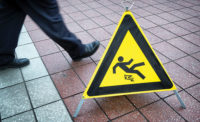Slips, trips & falls; natural disasters and storms; and fire top three employee safety concerns, according to survey

Slips, Trips and Falls: One in five report slipping, tripping or falling at work as their biggest concern. Accidents involving slips, trips and falls send nine million people to the hospital each year and are a leading cause of workers’ compensation claims, costing an average of approximately $20,000 per accident2.
Natural disasters and storms: Less than half of employees say their employers have the plans or equipment in place for snow and ice storms, or catastrophic events such as tornadoes, hurricanes or earthquakes. According to the Institute for Business and Home Safety, an estimated 25 percent of businesses do not reopen after a natural disaster3.
Fire: Fire is one of the most common safety incidents, but most employees feel their companies are well prepared. Three-fourths say their employers have a plan and equipment in place for a fire emergency.
Only half of employees believe their workplaces are prepared for a severe emergency, according to the survey. Nearly two-thirds of those polled said recent natural disasters have not led to their employers reassessing company safety plans. The survey also reveals that in the past six months nearly half of businesses have closed due to severe weather, costing the economy nearly $50 billion in lost productivity1.
“Safety is a top priority for employers, but there is still more planning and training that can be done to improve safety in the workplace,” said Bob Risk, national safety, health & wellness manager, Staples. “
Small business employees feel more at risk to emergencies and disasters than employees at larger companies.
The survey finds workers at businesses with fewer than 50 people are less aware or less sure who is in charge of emergency planning than employees at larger companies.
Employees from smaller companies report having less emergency equipment or plans in place, are less likely to do safety reviews or drills, and are less prepared for severe emergencies than their counterparts at bigger organizations.
Businesses should assess and make sure they comply with OSHA regulations. A good starting point of must-have safety products includes first-aid kits, fire extinguishers, crank-powered cell phone chargers and flashlights, personal protective equipment (such as protective clothing and respiratory protection), and the following emergency items: water/food, blankets, and exit signs.
A good safety plan includes procedures to respond to various emergency situations, methods to recover and maintain business continuity, securing adequate resources and supplies for crisis events and employee training.
To help limit slips, trips and falls in the workplaces, businesses should be vigilant about cleaning up spills immediately and posting signs identifying hazards, such as wet surfaces or areas that are being cleaned. Electrical cords are often an overlooked hazard – make sure these are not laid out in heavily foot traffic areas.
Resources:
- Interactive Infographic: http://www.staples.com/sbd/cre/marketing/safety-quiz/
- Staples Safety Research Center: www.staples.com/safetycenter
About the survey
Staples conducted an online survey of more than 400 office workers and 400 decision makers at organizations of all sizes across the U.S. The survey, conducted in May 2014, asked a series of questions about general office safety.
Looking for a reprint of this article?
From high-res PDFs to custom plaques, order your copy today!





